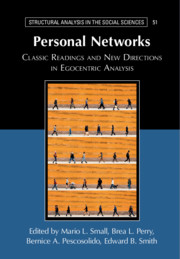Book contents
- Personal Networks
- Structural Analysis in the Social Sciences
- Personal Networks
- Copyright page
- Contents
- Figures
- Tables
- Contributors
- I Background
- II Early Foundations
- III Later Foundations
- IV New Perspectives
- 20 On Cognition
- 21 On Mobilization
- 22 On Trust
- 23 On Dynamics
- 24 On Inequality
- 25 On Culture
- 26 On Migration
- 27 On Movements
- 28 On Social Media
- Index
- Recent Books in the Series
- References
23 - On Dynamics
Personal Network Dynamics: Organizing Principles of Stability and Change from Complex Systems Theory
from IV - New Perspectives
Published online by Cambridge University Press: 01 October 2021
- Personal Networks
- Structural Analysis in the Social Sciences
- Personal Networks
- Copyright page
- Contents
- Figures
- Tables
- Contributors
- I Background
- II Early Foundations
- III Later Foundations
- IV New Perspectives
- 20 On Cognition
- 21 On Mobilization
- 22 On Trust
- 23 On Dynamics
- 24 On Inequality
- 25 On Culture
- 26 On Migration
- 27 On Movements
- 28 On Social Media
- Index
- Recent Books in the Series
- References
Summary
Research on personal social networks has focused increasingly on their dynamic nature. Social scientists across subfields have offered theories characterizing how, when, and why personal networks evolve, with applications to a range of populations, social conditions, and life course transitions. A persistent theme in this literature is the tension between stasis and adaptation. That is, personal social networks are characterized by remarkable structural stability and uniformity that belies a high degree of turnover at the level of interactions, individuals, and dyads. This chapter leverages core tenets of complex systems theories to provide insight into this paradox, arguing that personal networks operate in much the same way that complex adaptive systems do. In doing so, six organizing principles of personal network stability and change are offered: 1) Personal social networks serve a critical, unified function; 2) Personal networks adapt to dynamic and uncertain environments; 3) Personal networks are comprised of interconnected subgroups that have distinct, but complimentary functions; 4) Personal networks exhibit a hierarchical structure; 5) The structure of personal networks is relatively stable, while network membership is more dynamic and unpredictable; and 6) The dynamics underlying personal networks are nonlinear. Theoretical and methodological implications are discussed.
Keywords
- Type
- Chapter
- Information
- Personal NetworksClassic Readings and New Directions in Egocentric Analysis, pp. 612 - 629Publisher: Cambridge University PressPrint publication year: 2021
References
- 3
- Cited by

